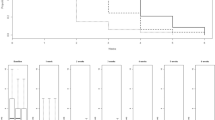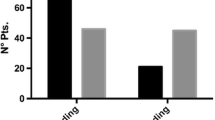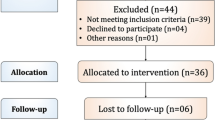Abstract
The aim of this study was to determine whether there was any relation between consumption of chilies and postoperative symptoms after hemorrhoidectomy in patients with grade III or IV hemorrhoidal disease. A total of 60 patients were randomly assigned to receive antibiotics and analgesics alone (control patients) or daily consumption of 3 g of chili powder along with identical antibiotics and analgesics (chili group). The evaluation of symptoms—pain, anal burning, pruritus, bleeding—during the postoperative period was assessed by means of patients’ self-questionnaires. A global score for evaluating each postoperative symptom was compared between the two groups at the 1-week follow-up. No significant difference in age, sex distribution, or grade of disease was noted between the two groups at baseline. The incidence of posthemorrhoidectomy symptoms was higher in the group consuming chilies during the first postoperative week. The global score for postoperative pain (14.60 for the chili group vs. 7.97 for the control group, p < 0.001) and for anal burning (12.90 for the chili group vs. 7.82 for the control group, p < 0.0001) were significant. Although bleeding (6.95 in the control group and 7.57 in the chili group, p < 0.81) and pruritus (8.06 in the control group and 8.75 in the chili group, p < 0.69) were more common in the chili group, the difference did not achieve statistical significance. This study shows that consumption of 3 g of red chilies per day during the postoperative period after hemorrhoidectomy increases the intensity of typical postoperative symptoms, stool frequency, and the consumption of analgesics.




Similar content being viewed by others
References
Desai HG, Venugopalan K, Antia FP (1973) Effect of red chili powder on DNA content of gastric aspirates. Gut 14:974–976
Denis J (1976) A study of some etiological factors in hemorroidal disease (author’s transl). Arch Fr Mal App Dig 65:529–536
Brooks MH, Brooks R (1996) Red pepper effect. Br J Gen Pract 46:759
Mende P, Siddiqi M, Preussmann R, et al. (1994) Identification of nitrophenols as nitrosation products from capsaicin and red chilies. Cancer Lett 83:277–282
Agarwal MK, Bhatia SJ, Desai SA, et al. (2002) Effect of red chilies on small bowel and colonic transit and rectal sensitivity in men with irritable bowel syndrome. Indian J Gastroenterol 21:179–182
al-Qarawi AA, Adam SE (1999) Effects of red chili (Capsicum frutescens L) on rats. Vet Hum Toxicol 41:293–295
Lewis EA, Aderoju EA (1978) Factors in the aetiology of chronic duodenal ulcer in Ibadan. Trop Geogr Med 30:75–79
Pigot F, Siproudhis L, Allaert FA (2005) Risk factors associated with hemorrhoidal symptoms in specialized consultation. Gastroenterol Clin Biol 29:1270–1274
Jensen SL (1988) Diet and other risk factors for fissure-in-ano: prospective case control study. Dis Colon Rectum 31:770–773
Johanson JF, Sonnenberg A (1994) Constipation is not a risk factor for hemorrhoids: a case-control study of potential etiological agents. Am J Gastroenterol 89:1981–1986
Delco F, Sonnenberg A (1998) Associations between hemorrhoids and other diagnoses. Dis Colon Rectum 41:1534–1541
Abdel-Salam OM, Szolcsanyi J, Mozsik G (1997) Capsaicin and the stomach: a review of experimental and clinical data. J Physiol Paris 91:151–171
Schmulson MJ, Valdovinos MA, Milke P (2003) Chili pepper and rectal hyperalgesia in irritable bowel syndrome. Am J Gastroenterol 98:1214–1215
Hoffmann P, Mazurkiewicz J, Holtmann G, et al. (2002) Capsaicin-sensitive nerve fibres induce epithelial cell proliferation, inflammatory cell immigration and transforming growth factor-alpha expression in the rat colonic mucosa in vivo. Scand J Gastroenterol 37:414–422
Nalini N, Manju V, Menon VP (2006) Effect of spices on lipid metabolism in 1,2-dimethylhydrazine-induced rat colon carcinogenesis. J Med Food 9:237–245
Rajaratnam SS, Boyle N, Owen WJ (2001) ‘Always chew your chilies’: a report of small bowel obstruction with perforation. Int J Clin Pract 55:146
Altomare DF, Rinaldi M, La Torre F, et al. (2006) Red hot chili pepper and hemorrhoids: the explosion of a myth—results of a prospective, randomized, placebo-controlled, crossover trial. Dis Colon Rectum 49:1018–1023
Kumar N, Vij JC, Sarin SK, et al. (1984) Do chilies influence healing of duodenal ulcer? Br Med J (Clin Res Ed) 288:1803–1804
Siddiqi M, Kumar R, Fazili Z, et al. (1992) Increased exposure to dietary amines and nitrate in a population at high risk of oesophageal and gastric cancer in Kashmir (India). Carcinogenesis 13:1331–1335
Aucoin EJ (1987) Pruritus ani. Postgrad Med 82:76–80
Addy L, Antonarakis G (2005) Incisor toothwear caused by a dietary habit involving chilies: a case report. Dent Update 32:213–214, 216
Balachandran B, Sivaramkrishnan VM (1995) Induction of tumours by Indian dietary constituents. Indian J Cancer 32:104–109
Sielezneff I, Antoine K, Lecuyer J, et al. (1998) [Is there a correlation between dietary habits and hemorrhoidal disease?] Presse Med 27:513–517
Kang JY, Alexander B, Barker F, et al. (1992) The effect of chili ingestion on gastrointestinal mucosal proliferation and azoxymethane-induced cancer in the rat. J Gastroenterol Hepatol 7:194–198
Lysy J, Sistiery-Ittah M, Israelit Y, et al. (2003) Topical capsaicin—a novel and effective treatment for idiopathic intractable pruritus ani: a randomised, placebo controlled, crossover study. Gut 52:1323–1326
Anand P (2003) Capsaicin and menthol in the treatment of itch and pain: recently cloned receptors provide the key. Gut 52:1233–1235
Author information
Authors and Affiliations
Corresponding author
Rights and permissions
About this article
Cite this article
Gupta, P.J. Effect of Red Chili Consumption on Postoperative Symptoms During the Posthemorrhoidectomy Period: Randomized, Double-blind, Controlled Study. World J Surg 31, 1822–1826 (2007). https://doi.org/10.1007/s00268-007-9148-6
Published:
Issue Date:
DOI: https://doi.org/10.1007/s00268-007-9148-6




